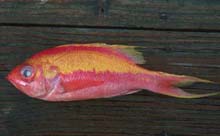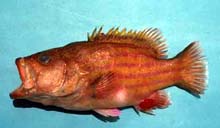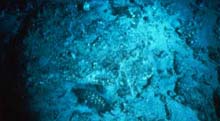
Large schools of streamer bass and other brightly colored "plankton pickers" live over hard bottoms and reefs on the deep shelf and upper continental slope in the southeast Atlantic and Caribbean Sea. Click image for larger view.
A Profile of Cape Fear Terrace
Fritz Rohde, North Carolina Division of Marine Fisheries
Steve Ross, North Carolina National Estuarine Research Reserve
Description
Extensive hard ground (reef) habitat accounts for about 23% of the available habitat throughout the South Atlantic Bight continental shelf. Generally, these reefs are fossiliferous limestone and sandstone outcrops. These can be divided into two more or less distinct continental shelf habitats. The live-bottom habitat (30-64 meter depth) consists of low rock ridges, outcroppings, coral patches, and ship wrecks. The shelf-break habitat is a fairly continuous band of high profile (5-20+ meters) hard grounds in depths greater than 64 meters and consists of jagged peaks, precipitous cliffs, and rocky ledges. This habitat is particularly extensive off North Carolina in Onslow Bay. These deepwater outcrops, along with the many shipwrecks in the region, support a diverse assemblage of tropical and subtropical fishes. A number of species, such as the roughtongue bass, streamer bass, and red barbier, are not found on shallower live-bottom reefs. Major commercial and recreational fisheries exploit these reef fish communities with North Carolina representing the northernmost range of these fisheries. North Carolina ranks second to Florida in total commercial reef fish landings. In 2000, North Carolina commercial fishing vessels landed 39% of the total reef fish landings in the South Atlantic Bight: 69% of the black sea bass, 65% blueline tilefish, 54% red grouper, 52% white grunt, 48% vermilion snapper, and 37% snowy grouper.
Mission Objectives
The mission objective for this segment of the Islands in the Stream/South Atlantic Bight Expedition is to conduct systematic fish surveys of two shelf-break areas in Onslow Bay. The Steeples includes a large, high-profile shelf-edge complex (55-140 m depth) off Cape Fear that has a diverse depth and habitat range. The second area, northeast of the Steeples, has been proposed as a marine protected area because it is believed to be a spawning aggregation site for red porgy, gag, and snowy grouper. Fishers exploit both of these areas.
Habitats
Habitats to be examined include:
- deep rocky reef
- ledges
- pinnacle
- patch reef
- hard bottom.
Key Species
Gag Mycteroperca microlepis Scamp Mycteroperca phenax Speckled hind Epinephelus drummondhayi Snowy grouper Epinephleus niveatus Vermilion snapper Rhomboplites aurorubens Red porgy Pagrus pagrus
Protected Areas
An advisory committee to the South Atlantic Fishery Management Council has proposed one marine protected area in this region.

The Spanish flag is a fish species rare to the North Carolina continental shelf area. Click image for larger view.
Interesting Facts
- Onslow Bay contains part of the outer shelf reef complex of the South Atlantic Bight and supports major commercial and recreational fisheries. More than one-third of commercial fish landings in the South Atlantic comes from these waters.
- This area represents the northernmost distribution of many subtropical reef fish. A number of fish new or rare to the outer continental shelf of the South Atlantic Bight were captured here.
- This shelf-edge habitat is considered crucial spawning habitat for many commercially important species of groupers and snappers.
Sign up for the Ocean Explorer E-mail Update List.












































